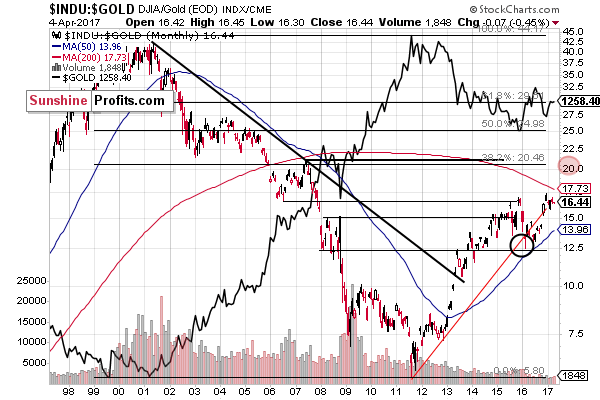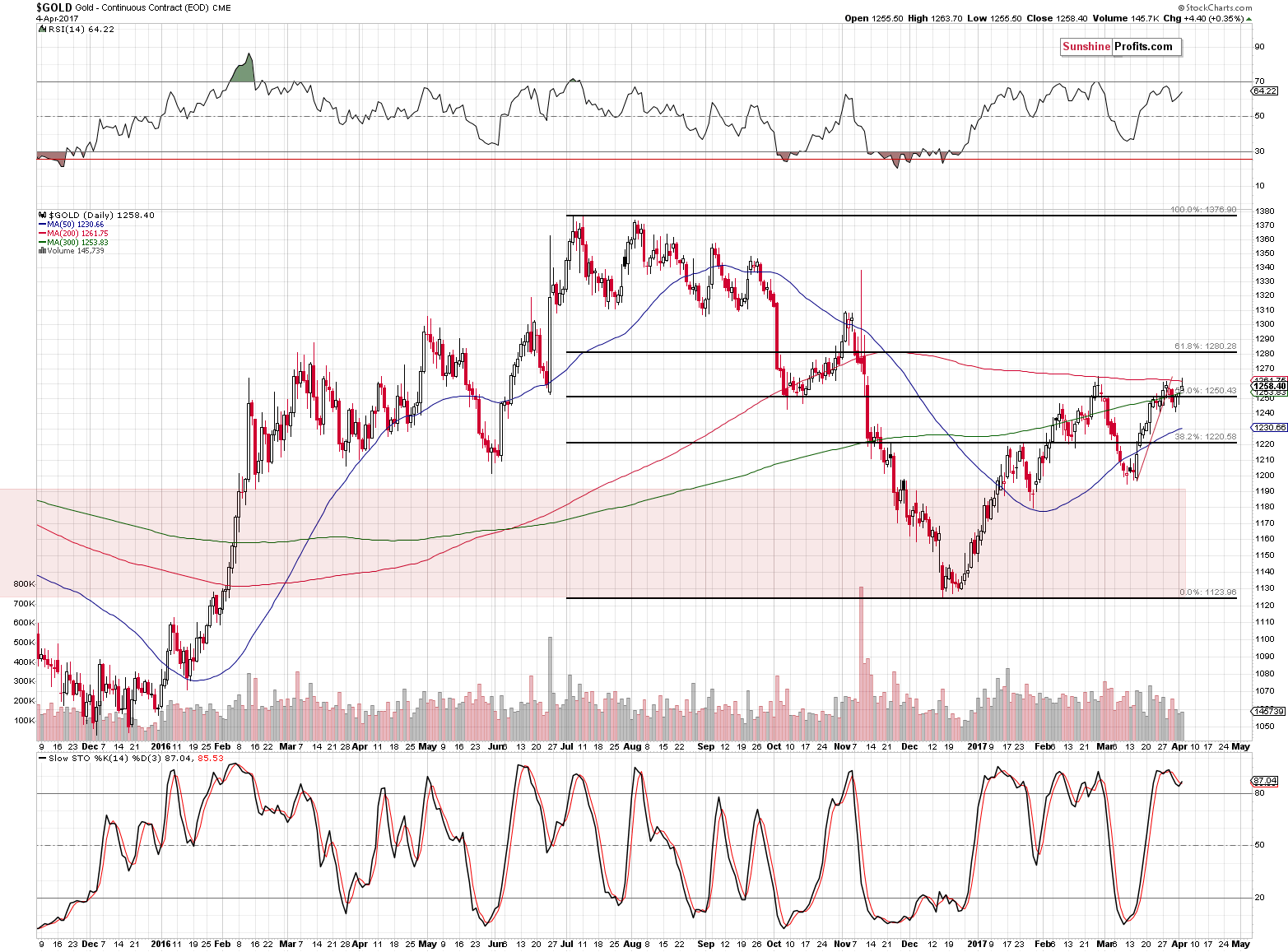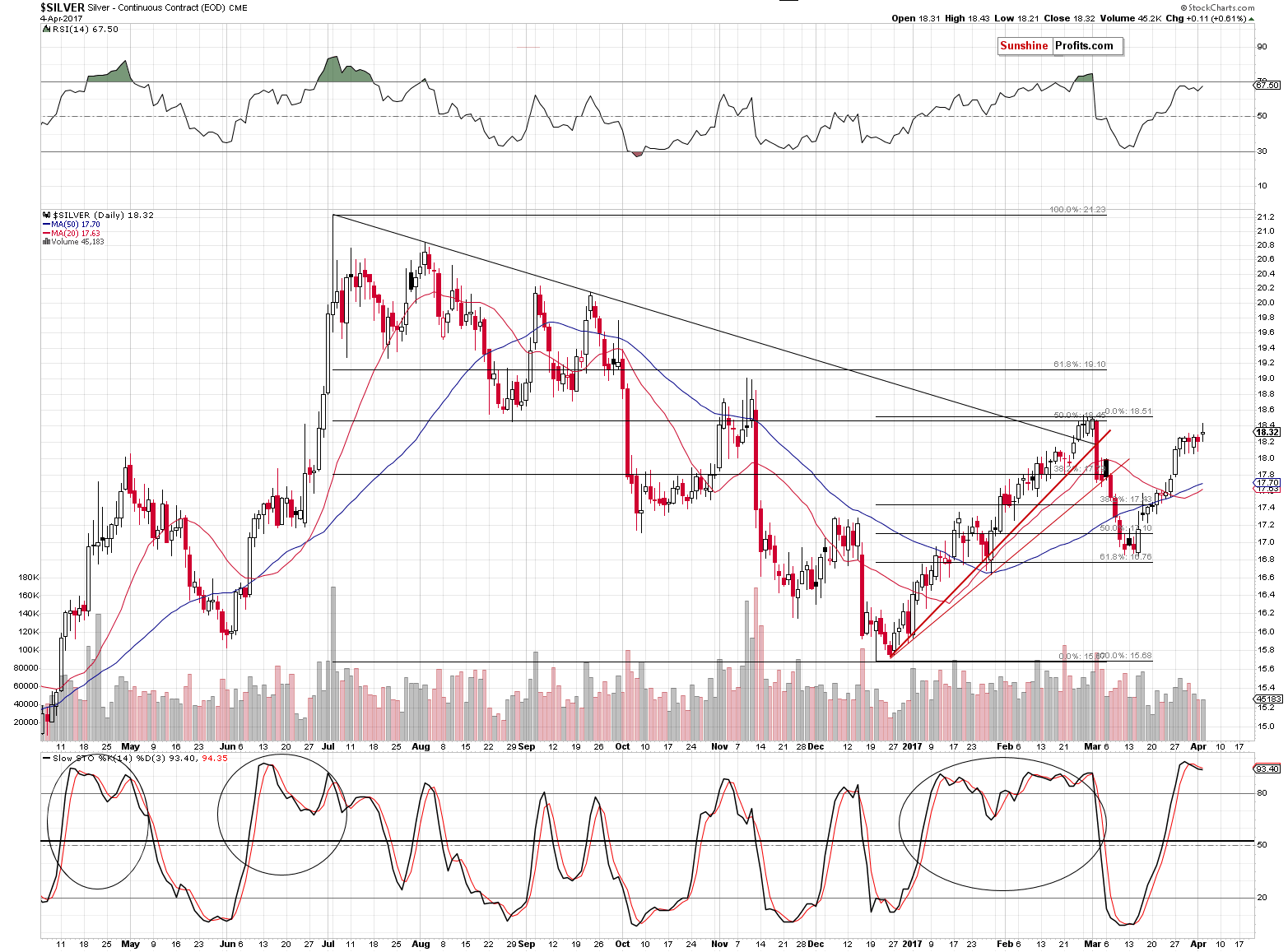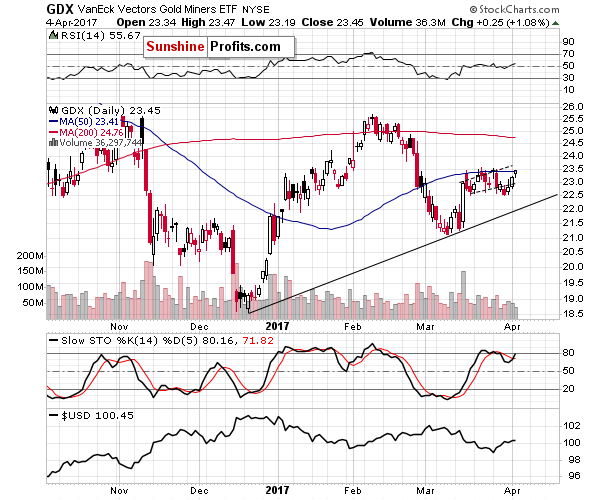Briefly: In our opinion, full (150% of the regular full position) speculative short positions in gold, silver and mining stocks are justified from the risk/reward perspective. This position was originally featured on Jan. 12, 2017 at 3:49PM.
In the two previous alerts, we discussed several important long-term factors that are present in gold and silver and their implications for the following weeks and months. However, there are additional factors that need to be considered as well. One of them is gold’s relationship with the stock market. We discuss the details in today’s alert.
Why is this ratio between stocks and gold so important? Due to the same reason that the gold-to-bonds ratio is important – these markets represent primary parts of most investors’ portfolios and since investors are often moving from one asset class to the other, the relative valuations thereof could change faster than the prices of the assets themselves. Consequently, the technical developments in the ratios could be the leading indicator for developments in case of assets (like gold). So, what’s happening in the Dow-to-gold ratio? Let’s take a look at the chart (charts courtesy of http://stockcharts.com).

In the past months, the Dow-to-gold ratio moved above its 2015 high and it appears to be verifying this breakout by moving back and forth around it. The rising support line remains in place, which makes subsequent rallies likely. The opposite is likely for gold (there’s an inverse relationship between the ratio and gold) and if the technical developments in the ratio are really heralding developments in gold, we can expect gold to break below the 2015 bottom later this year.
What’s the likely target for the ratio in the coming months? The 20-20.5 area as that’s where we have the next strong (!) resistance levels. That’s where we have the first of the classic Fibonacci retracement levels (38.2%) and the 2007 top. The ratio is likely to rally substantially in the coming months and the opposite is the case for gold.
Moving on to the recent developments, we can once again say that nothing really changed.

Gold moved higher on low volume and before the session was over, it invalidated the intra-day move above this year’s highs.

Silver appears to have finally moved, but in reality, it didn’t – it’s at $18.21 at the moment of writing these words, so it’s quite in tune with the previous very short-term trading range. Besides, the supposed breakout would not be confirmed by significant volume, which would make it prone to invalidation anyway (which seems to have already happened).

Mining stocks moved higher on very low volume and stopped the rally practically right at the previous highs and the 50-day moving average. Even though the breakdown below the flag pattern was invalidated, nothing changed to make the situation bullish. The size of yesterday’s volume suggests that we are going to see lower values of mining stocks sooner rather than later.
Summing up, the Dow to gold ratio chart is another reason to expect lower gold prices in the coming weeks and months, even if gold doesn’t slide in the next several days. The long-term analogy to 2002 and 2003 in the USD Index remains in place and it fully supports the above outlook and the same goes for the bearish long-term signs form the silver market, gold-to-bonds ratio and the analysis of the 50-week moving averages.
As always, we will keep you – our subscribers – informed.
To summarize:
Trading capital (supplementary part of the portfolio; our opinion): Short positions (150% of the full position) in gold, silver and mining stocks are justified from the risk/reward perspective with the following stop-loss orders and initial target price levels / profit-take orders:
- Gold: exit-profit-take level: $1,063; stop-loss: $1,273; initial target price for the DGLD ETN: $81.88; stop-loss for the DGLD ETN $48.17
- Silver: initial target price: $13.12; stop-loss: $18.67; initial target price for the DSLV ETN: $46.18; stop-loss for the DSLV ETN $19.87
- Mining stocks (price levels for the GDX ETF): initial target price: $9.34; stop-loss: $26.34; initial target price for the DUST ETF: $143.56; stop-loss for the DUST ETF $21.37
In case one wants to bet on junior mining stocks' prices (we do not suggest doing so – we think senior mining stocks are more predictable in the case of short-term trades – if one wants to do it anyway, we provide the details), here are the stop-loss details and initial target prices:
- GDXJ ETF: initial target price: $14.13; stop-loss: $45.31
- JDST ETF: initial target price: $104.26; stop-loss: $10.78
Long-term capital (core part of the portfolio; our opinion): No positions (in other words: cash)
Insurance capital (core part of the portfolio; our opinion): Full position
Please note that the in the trading section we describe the situation for the day that the alert is posted. In other words, it we are writing about a speculative position, it means that it is up-to-date on the day it was posted. We are also featuring the initial target prices, so that you can decide whether keeping a position on a given day is something that is in tune with your approach (some moves are too small for medium-term traders and some might appear too big for day-traders).
Plus, you might want to read why our stop-loss orders are usually relatively far from the current price.
Please note that a full position doesn’t mean using all of the capital for a given trade. You will find details on our thoughts on gold portfolio structuring in the Key Insights section on our website.
As a reminder – “initial target price” means exactly that – an “initial” one, it’s not a price level at which we suggest closing positions. If this becomes the case (like it did in the previous trade) we will refer to these levels as levels of exit orders (exactly as we’ve done previously). Stop-loss levels, however, are naturally not “initial”, but something that, in our opinion, might be entered as an order.
Since it is impossible to synchronize target prices and stop-loss levels for all the ETFs and ETNs with the main markets that we provide these levels for (gold, silver and mining stocks – the GDX ETF), the stop-loss levels and target prices for other ETNs and ETF (among other: UGLD, DGLD, USLV, DSLV, NUGT, DUST, JNUG, JDST) are provided as supplementary, and not as “final”. This means that if a stop-loss or a target level is reached for any of the “additional instruments” (DGLD for instance), but not for the “main instrument” (gold in this case), we will view positions in both gold and DGLD as still open and the stop-loss for DGLD would have to be moved lower. On the other hand, if gold moves to a stop-loss level but DGLD doesn’t, then we will view both positions (in gold and DGLD) as closed. In other words, since it’s not possible to be 100% certain that each related instrument moves to a given level when the underlying instrument does, we can’t provide levels that would be binding. The levels that we do provide are our best estimate of the levels that will correspond to the levels in the underlying assets, but it will be the underlying assets that one will need to focus on regarding the signs pointing to closing a given position or keeping it open. We might adjust the levels in the “additional instruments” without adjusting the levels in the “main instruments”, which will simply mean that we have improved our estimation of these levels, not that we changed our outlook on the markets. We are already working on a tool that would update these levels on a daily basis for the most popular ETFs, ETNs and individual mining stocks.
Our preferred ways to invest in and to trade gold along with the reasoning can be found in the how to buy gold section. Additionally, our preferred ETFs and ETNs can be found in our Gold & Silver ETF Ranking.
As always, we'll keep you - our subscribers - updated should our views on the market change. We will continue to send out Gold & Silver Trading Alerts on each trading day and we will send additional Alerts whenever appropriate.
The trading position presented above is the netted version of positions based on subjective signals (opinion) from your Editor, and the Tools and Indicators.
As a reminder, Gold & Silver Trading Alerts are posted before or on each trading day (we usually post them before the opening bell, but we don't promise doing that each day). If there's anything urgent, we will send you an additional small alert before posting the main one.
=====
Latest Free Trading Alerts:
The inflation rate in the euro area fell in March. What does it mean for the gold market?
Softening Eurozone Inflation and Gold
=====
Hand-picked precious-metals-related links:
Whether Fear or Greed, New Crop of Investors are Seeking Gold
Busting the Myth That Gold Is a Good Investment Right Now
INTERACTIVE MAP: World's top 10 gold deposits
How Goldcorp Inc. Makes Most of Its Money
=====
In other news:
Stock Futures Under Pressure Ahead of Fed Minutes, U.S.-China Meeting
Richmond Fed President Jeffrey Lacker Resigns After Admitting To 2012 Leak
Global debt explodes at 'eye-watering' pace to hit £170 trillion
Dimon Warns ‘Something Is Wrong’ With the U.S.
UK consumer slowdown underway, caution needed on rates: Bank of England's Vlieghe
EU's Tusk says Greece, lenders close to concluding bailout review
Le Pen Ambushed in French Debate as Macron Attacks on Euro
=====
Thank you.
Sincerely,
Przemyslaw Radomski, CFA
Founder, Editor-in-chief, Gold & Silver Fund Manager
Gold & Silver Trading Alerts
Forex Trading Alerts
Oil Investment Updates
Oil Trading Alerts



